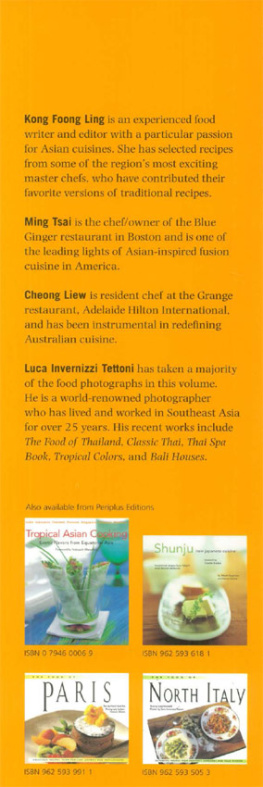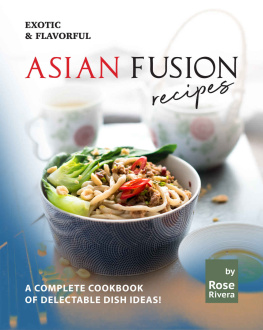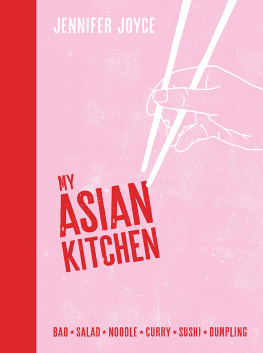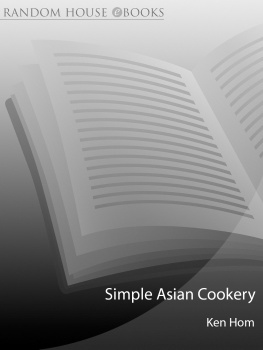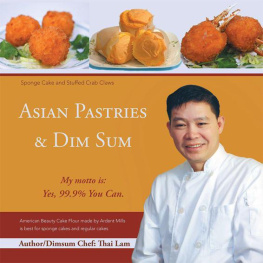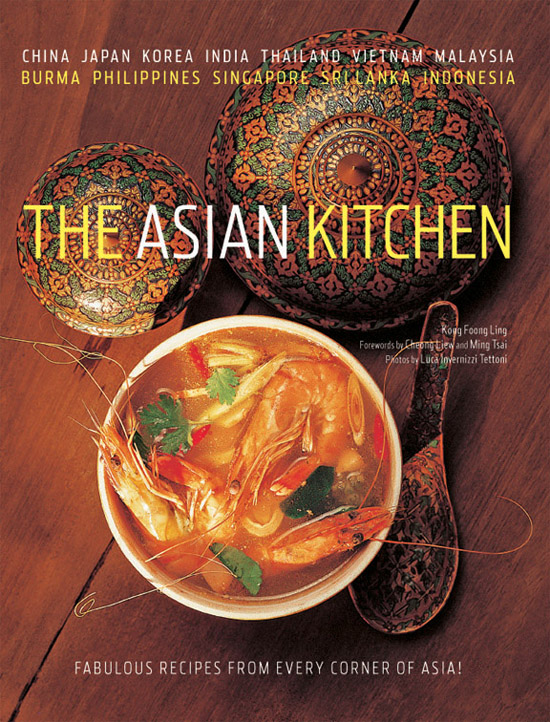

Asian Ingredients
Most of the ingredients called for in this book are readily found at Chinese or Asian grocery stores and well-stocked supermarkets.

AGAR-AGAR A setting agent derived from seaweed which hardens without refrigeration and is used for cakes and desserts. It comes in long strands or in powder form; 1 teaspoon of powder sets 1-1 cups liquid. To use, sprinkle powdered agar-agar over liquid and bring it gently to a boil, stirring until dissolved.
ANNATTO SEEDS The dark reddish-brown seeds of the lipstick plant and are commonly used as a coloring agent. Usually the seeds are fried in oil to extract their brick red color, then discarded. Commonly available where Caribbean foods are sold.
ASAFOETIDA A strong-smelling brown tree resin. Known in India as hing, it adds an oniony flavor to cooked foods and is believed to aid digestion. Often used in lentil dishes, it is sold in a box or tin as a solid lump, or in the form of powder.
ASAM GELUGUR The Malay name for the sweet-sour garcinia fruit that resembles a dried apple. Dried slices of the fruit are used in some Malay and Nonya dishes and tamarind may be used as a substitute.
ASIAN CELERY The celery used in Asia is much smaller than the Western variety, with slender stems and particularly pungent leaves. Often known as Chinese celery and used as a herb rather than vegetable, it is added to soups, rice dishes and stir-fries. Substitute regular celery leaves or Italian parsley.
ASIAN EGGPLANTS Known also as aubergine or brinjal, this vegetable is much smaller and thinner throughout Asia than its Western counterpart. Japanese eggplants are often no more than about 4-8 in (10-20 cm) long. The Thais also use a rather bitter pea-sized eggplant and the apple variety. Use slender Asian or Japanese eggplants for all recipes in this bookthey are less bitter and have a better texture. They do not need salting before use.
AZUKI BEANS Small red beans that are sold dried and need to be soaked before using. Azuki beans are cooked, sweetened and sometimes mashed into a paste to make desserts. Cooked, sweetened red beans are readily available canned in Asian supermarkets.
BABY ANCHOVIES, DRIED Also known as ikan bilis, these are tiny whitebait fish ranging from 1-2 in (2-5 cm) in length. They are usually sold in Asiasalted and sun-dried. Remove the head and black intestinal tract before using. If possible, buy them split, cleaned and ready for use. Ikan bilis are usually quite salty, so taste any dish using ikan bilis before adding more salt. They are used as a seasoning or deep-fried with chilies and peanuts to make a crunchy side dish or appetizer.
BANGKUANG See JICAMA.
BAMBOO SHOOTS The fresh shoots of the bamboo plant that makes an excellent vegetable. Fresh shoots taste better than canned, but must be peeled, sliced and simmered in water for about 30 minutes before using. Ready-to-use sliced bamboo shoots, packed in water, can be found in the refrigerated produce section of some supermarkets and are convenient and easy to use. Canned bamboo shoots should be boiled for 5 minutes to reduce any metallic flavor before using. Both fresh and canned bamboo shoots are increasingly available in many supermarkets.
BANANA BLOSSOM The unopened male flowers of the banana planta purple-red inflorescence tinged with yellow at the base which hangs at the end of a clump of developing bananas. Tasting like artichokes, the hearts of these flowers, which have been stripped off their purple petals, are a popular salad ingredient in some Southeast Asian cuisines, especially in Vietnam. Fresh, canned and dried banana blossoms can often be found in specialty stores outside Asia, particularly those stocking Vietnamese and Thai ingredients. Choose a firm, large blossom with an even color and check that the outer petals are not wilted. To prepare the blossom for cooking, remove the coarse outer petals to reveal the creamy white heart. Quarter the heart lengthwise with an oiled stainless steel knife to avoid the sticky sap from clinging to it. If not cooking immediately, soak in cold water or rub with lemon or lime juice to avoid discoloration. Simmer the cut heart in plenty of lightly salted water until tender, about 15 to 20 minutes. Drain, cool then pull out and discard the hard filaments inside each cluster of yellow stamens as they have an unpleasant texture.

BANANA LEAVES infuse a delicate flavor and aroma to foods. They are often used as wrappers when steaming or grilling dishes, or as little trays to hold food when cooking. Soften them in boiling water before use to prevent them from cracking when wrapping foods. Fresh banana leaves are sometimes sold in Hispanic or Asian markets, but frozen banana leaves are more readily available. If banana leaves are not available, aluminum foil can be used, though it does not impart the subtle flavors that banana leaves do.

BASIL This is often used as a seasoning and garnish in Thai cooking, and there are several types. The most commonly used basil is known as Thai basil or horapa and is fairly similar to European or American sweet basil. It is used liberally as a seasoning and sprigs of it are often added to platters of fresh raw vegetables. Lemon basil or manglak is similar to horapa but paler and with a distinctive lemony fragrance. It is used in soups and salads. Holy basil, known in Thailand as kraprow, has a fragrance redolent of cloves. Its taste is sharp and hot and it is mainly used in spicy stir-fries. Basil is known as daun selasih or kemangi in Indonesia. Thai basils are commonly available in Asian food stores and many supermarkets, but sweet basil makes an acceptable substitute.
BELIMBING WULUH See CARAMBOLA.
BESAN A pale yellow flour which has been finely ground from channa da l (Bengal gram) or the yellow split pea. It is sometimes referred to as chickpea flour, Bengal gram flour or simply gram flour. It is commonly found in Asian food stores and some health food stores.
BLACK BEANS, SALTED Also called fermented black beans or Chinese black beans. They are soybeans that have been fermented and preserved in salt, hence their strong, salty flavor. Mainly used to season a number of dishes, especially fish, beef and chicken, they are sold in packets or cans and can be kept for several months if stored in the refrigerator. Soak in warm water for 30 minutes before using, to remove excess salt.
BLACK CHINESE VINEGAR Made from rice, wheat and millet or sorghum. The best black vinegars are well-aged and have a complex, smoky flavor similar to balsamic, which may be substituted. Chinese cooks add black vinegar sparingly to sauces, dips and when braising meats.
BLACK MOSS FUNGUS A fine, hair-like fungus valued in Chinese cooking. Soak in warm water until pliable before using.
BOK CHOY A highly nutritious variety of cabbage with long, crisp stalks and spinach-like leaves. It has a clean, slightly peppery flavor and is a wonderful addition to soups and stir-fries. It is available in most well-stocked supermarkets.


